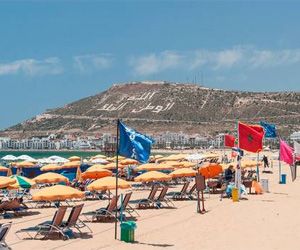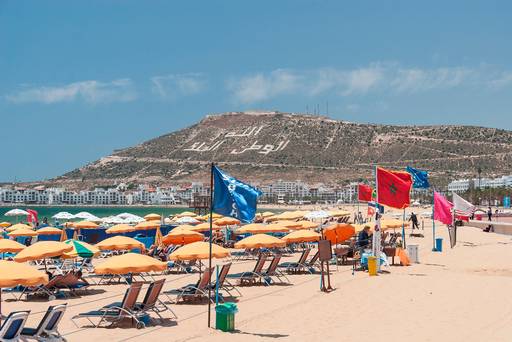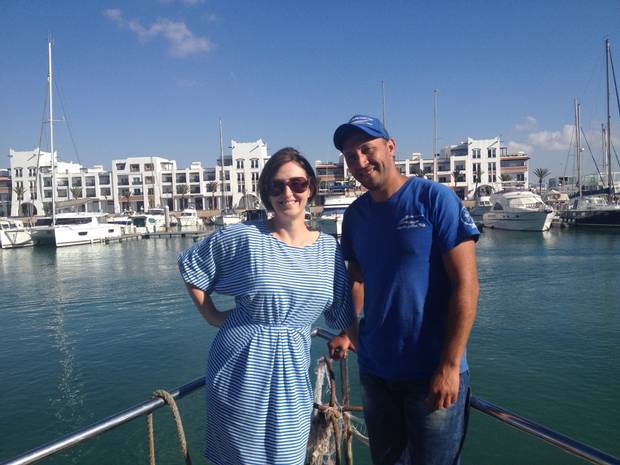
15 Mar Morocco: Wham, bam, thank you hammam in Agadir
Adventures in Agadir, Morocco

Casbah Mountain and coastline, Agadir
A winter sun break in Agadir will lift your spirits and have you in relaxation mode at warp speed…
There are cats everywhere in Agadir, and while they’re not of the pampered variety I have at home, they are, in the main, cared for by the locals.
This generosity isn’t wholly altruistic – the city’s denizens need the cats just as much as the cats need them.
Just before midnight on February 29, 1960, Agadir was hit by an earthquake that lasted 15 seconds; it killed 15,000 people and left 35,000 homeless. After the horrific event, which forever changed the face of the ancient city, people realised that before the earthquake had hit, the city’s cats had become agitated and fled.
Felines, it transpires, are sensitive to the first faint vibrations underground and now act as an early warning system for the populace, who know that the stray they feed may one day save their lives.
I arrived in the beach-side city at the tail-end of January, having left behind the cold and drear in the hope of shaking off the winter blues. From the off, Agadir’s balmy air warmed my bones and lifted my spirits: the bleakest month is no trial in northern Africa.

Agadir marina
Anne, my companion, decided we should start the week as we meant to go on: with some serious pampering. Having checked in to our base, the perfectly located Kenzi Europa Hotel, we made a beeline across the road to the five-star Royal Atlas Spa. We plumped for the exotic-sounding Warmth of the South hammam, aka 90 minutes of bliss.
The spa, which is decorated in traditional Moroccan style – think marble, ornate doors and scalloped-edge pools – has a womb-like feel, and once we had been scrubbed, gourmet-wrapped and then massaged from head to toe, the wisdom of our decision became clear. We’d reached holiday relaxation mode at warp speed, you see; the January gloom had dissolved in the lashings of argan oil that now softened our previously prunish pelts. Result. It was early to bed that night, having dined on traditional tagines at Le P’tit Dome, a restaurant on our road, Boulevard 20 Aout. Our laid-back state was further enhanced by a several glasses of grey wine – a pale rose made from black grapes.
As a wise rat once said, “there is nothing, absolutely nothing, half so much worth doing as simply messing about in boats”, so next morning, after a hearty breakfast of freshly made omelettes and Moroccan mint tea, we took Ratty’s advice.
We were met at the marina – Agadir’s posh end; it has an excellent Zara – by the affable Brahim, who was our host aboard the Golden Trip yacht (See agadirgoldentrip.com). Having dropped anchor far out in Agadir’s beautiful bay, he helped us bait our lines and cast them into the depths, patiently rebaiting them each time the wily fish below outsmarted the hook’s barb. Our luck was out, but other passengers fared better, hooking dorada and rskas, which they generously returned to the deep, having recorded their catch for posterity.
A bright morning segued into a sunny afternoon, and we were without care as we set sail again, with lunch sizzling on the starboard barbecue. We sipped on our stash of rose (alcohol isn’t served, but it’s fine to take your own) as our onboard companions braved the chilly waters for a preprandial swim. Lunch over, our vessel made her way back to shore, and as it was still light, we eschewed our ride, choosing instead to feel the warm sand of the bay’s beach between our toes.
At our welcome meeting, our genial rep, Touria, had advised us of restaurants to try, and that night we set out to explore the traditional Moroccan eateries of the Talborjt district, where you can get fed for €4. We got lost, due to my skewed sense of direction, but ended up dining at a locals’ spot nonetheless.
Restaurant Poisson Al Jazera, on Rue Des Orangers, while not fancy by any stretch, is a ichthyophile’s delight, with the freshest of fish on offer. We dined on lip-smackingly good whitebait and divine dorada, which Abdul, our waiter, skilfully deboned at our table. (They didn’t serve wine, but Abdul produced two glasses of white from somewhere when he saw our crestfallen faces). Our bill was more expensive than anticipated, so we haggled it down to €54; still on the dear side considering the surroundings, but the fish was unarguably stellar.
It was now hammam o’clock, and this time we headed to Argan Phyto House, as recommended by Touria, and, indeed, the web. While tiles replaced marble and tasselled curtains hung in place of antique doors, the experience at APH was no less memorable (albeit cheaper at €40).
With hammams, it’s best to leave one’s modesty at the door; as, nether regions aside, every other bit of us was washed, scrubbed and massaged to within an inch of its life. Needless to say, we slept like babies (arganphytohouse.com).
Next morning, we were off to the delightfully named Paradise Valley for a half-day trip, organised through Touria (330 dirhams/€30). The Moroccan countryside is, in its own way, quite lush. Argan and olive trees abound, and in the shadow of the mighty Atlas mountains, Paradise Valley revealed its abundance: banana trees, date palms – sacred trees, allowed to grow where they spring up – orange trees, pomegranate trees, fig cacti and prickly pear (good for the runs, apparently).
We tracked the trickling river through the valley, our group herded along by a friendly canine. In the depths of the fertile valley we came upon an old man on his knees, harvesting alfalfa by hand: food for his animals. Morocco is a juxtaposition of old ways and new; much work is done by hand and donkeys abound, carrying loads bigger than themselves.
But this seeming backwardness belies the fact that, in stark contrast to the rest of Africa, more than 99pc of Moroccan homes have electricity, and the country, a constitutional monarchy, which has a history of independence not shared by its neighbours, is that continent’s fifth largest economy.
After a tagine lunch at restaurant Tanout, with the valley’s panorama as our backdrop, it was time to head back, with a pitstop at an argan oil co-operative. Known as the white gold of the Berber women, the precious vitamin-rich oil, from the fruit of the argan tree, has proved a boon to the region’s females, providing them with an income and a degree of independence.

The beautiful beach at Agadir – the ‘Miami of Morocco’ – with the walls of the 16th century kasbah visible on the hill in the background
Extracting the oil is labour-intensive; it takes one woman six days to produce a kilo of argan kernels by cracking open the hard fruit with a stone; 2.2 kilos are needed to produce one litre of oil. The co-op we visit has a lovingly tended herb garden, and also produces honey from the bees who pollinate its plants; we ooh and ahh over the sweet nectar before pronouncing the orange honey a clear winner.
That evening, we hit the Royal Atlas Spa for another peerless hammam. Now so relaxed we are almost floating, to maximise our new-found bliss, we decide to spend the following day doing… absolutely nothing. By the pool, of course, waited on hand and foot by the superlative Kenzi Europa staff.
Our holiday was drawing to a close, but we had a final adventure to pursue: a night in the Sahara (1550 dirhams/€145). Mustafa, our genial guide, collected us bright and early for what proved to be a long journey; one of discovery. The vastness of the burnt-umber landscape, dotted with the deep green of the argan tree, lingers long in the memory.
It is here, away from civilisation, that you feel the magic that is Africa. The wildness, the hugeness of it; an alien landscape that your soul seems to remember, deep down.
Our route led us to the silver city of Tiznit – named, according to legend, after a prostitute, Lalla Tiznit. It’s famous for intricate filigree silver; the skills for which were passed on to the locals by Jewish artisans in the 1880s. Next was lunch overlooking romantic Legzira Beach, with its stunning natural arch; its companion sadly collapsed into the sea last year. Finally, after many hours, capped by a bone-shaking 10km off-road, we reach Fort Bou-Jerif – gateway to the Sahara.
It’s almost dusk as we reach the fort, which was built by the French in the early 20th century and occupied by French Foreign Legion troops until 1956, when France withdrew from Morocco. The crumbling walls of the once-mighty edifice are now being reclaimed by the earth, and larks, wheatears and sandgrouses circle the skies overhead. It’s a desolate spot, but an incredibly beautiful one, with long-forgotten stories echoing through every passageway.
Our bed for the night is a khaima, a nomad’s tent – thankfully pitched within spitting distance of the bathroom block. Dinner, and several glasses of Moroccan vin blanc, were enjoyed in the tiny hotel named for, and adjacent to, the fort. Run by a French couple, Pierre and Najet, who decamped from Marseille some years ago, the hotel has a 1950s feel, with its leopard-skin wall hangings and terrazzo floors; very desert chic.
Our tent is not quite so well-appointed, and while Anne is out like a light, I toss and turn, discomfited by the howling wind and thoughts of slithering snakes. My restless night held compensation at its end; I awoke to see the unforgettable desert dawn: the purple night sky fading to blue and gold; the sun’s light, full of possibility and hope, spreading its warmth across the vast russet dunes.
We spent our last night in Pure Passion, a fancy eating spot in the marina, with food to die for and a free lift back to the Kenzi (they do pick-up, too) See purepassion.ma/en. Our last morning brought the rain, but no matter, before our flight home, we’d booked in for one last hammam – with a two-hour massage.
It’s the first time I’ve ever had my eyelids massaged. But not the last. Guess where I’m going next January…
TAKE TWO: Top attractions
Fort Bou-Jerif
Take the Sahara, add a crumbling fort in the middle of nowhere, some magical African light, and an inky sky glittering with stars — it just doesn’t get more romantic. It’s a bit of a trek to get to Fort Bou-Jerif, but boy, is it worth it! See boujerif.com
The Souk
Don’t leave Agadir without visiting Souk El Had; it’s the quintessential Moroccan experience. Anything you might desire is here, but stick with leather goods and pottery. Both are fantastic value — as long as you haggle! I got three beautiful bowls for a paltry €15 from Ayoub at stall 293.
Getting there
Gemma travelled with Sunway to Morocco and stayed in the four- star Kenzi Europa Hotel in Agadir, Morocco, on a bed and breakfast basis. Packages include flights, transfers, seven nights’ accommodation, all taxes and charges, 20kg baggage and a Sunway representative. To find more about Morocco holidays please call us at 01 2311800 or visit our website www.sunway.ie
Writen By Gemma Fullam
Issue date February 13 2017
Website independent.ie

Sorry, the comment form is closed at this time.